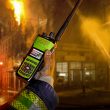FCC OKs looser mask for 4.9 GHz
Government communication officials, who hope to leverage commercial technology in the public-safety band, welcomed an FCC ruling adopting looser emissions masks for equipment operating at 4.9 GHz.
With the unanimous decision on Nov. 9, the FCC changed the previous emission mask for the band. Public-safety officials said the previous mask, supported by Motorola, effectively would limit the number of vendors competing for government contracts for data solutions in the dedicated public-safety band. The new, looser mask is designed to let public-safety entities leverage commercial off-the-shelf equipment to design systems that are more cost-efficient and feature-rich.
“I think it’s important that public-safety personnel have access to information on the ground during times of emergency, whether it’s building layouts or medical information about people,” said FCC Commissioner Kevin Martin during the meeting. “I think the ability to utilize off-the-shelf equipment in neighboring bands is critical to bringing down the cost of doing so.”
The projected cost savings are a product of equipment manufacturers not having to expend additional funds to change their processes to meet a unique set of specifications for the limited public-safety market. Instead, they can offer equipment that can be used by public safety as well as the much larger commercial market — at reduced costs and greater innovation.
“The real benefit is the semiconductor companies don’t have to do anything different … so we’ll have a very large radio base to choose from,” said Michael Howse, PacketHop CEO. “Today’s radio can already work in that spectrum.”
Indeed, with the looser mask, commercial wireless networking companies such as Tropos Networks will compete for 4.9 GHz contracts, according to Ron Sege, Tropos Networks President and CEO.
“We could have [complied with the tighter mask to compete for public-safety contracts], but we wouldn’t have done it … it wouldn’t have sense economically,” Sege said. “So as a practical matter, [the tighter mask] would have scared away competition.”
Sege said government entities must carefully consider whether they want to spend the funds necessary to put a wireless data network at 4.9 GHz. The public-safety band’s high frequency means three or four times as many nodes are needed to provide the same performance as similar networks operating at 2.4 GHz, he said. The differences are even greater when compared to a 700 MHz network, which provides the same performance with one node as 10 nodes provide at 4.9 GHz.
Although the new emission masks should meet public safety’s technological needs, the FCC ruling did not address potential operational problems in the 4.9 GHz band, according to Steve Devine, patrol frequency coordinator for the Missouri Highway Patrol and chairman of National Public Safety Telecommunications Council’s 4.9 GHz Task Force.
While dedicated to public safety, the 50 MHz swath of spectrum at 4.9 GHz is not parceled out to individual entities as is done at 700 MHz and 800 MHz. Users of the lower bands are required to follow the rules of the appropriate regional planning committee. At 4.9 GHz, “no one is in charge” of regional planning — a concern the FCC declined to address in its order, Devine said.
“There’s no authority, so… no one is there to smooth out the local in-fighting,” he said. “It may work out in the end, but I’ve got a feeling it could be ugly in the interim.”
While not mandated by FCC rules, Devine said there is ample incentive for public-safety entities operating in the band to work with others using the frequencies. If such an understanding doesn’t exist, investments in 4.9 GHz wireless data networks may not yield the expected performance, he said.
“Those that cooperate well will do great in this band,” Devine said. “Those that don’t will be hindered.”
on the web:
For more more news, visit our Web site:
WWW.MRTMAG.COM.COM

















